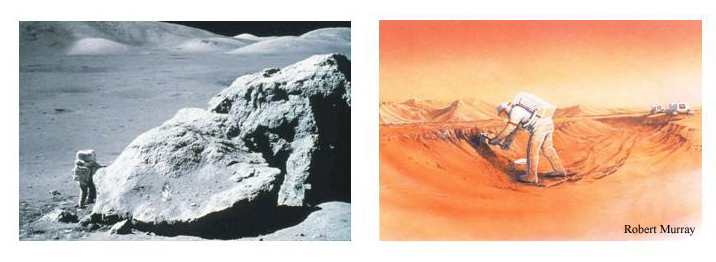
Field Geologists on the Moon and Mars (courtesy of NASA and Robert Murray,
respectively)

Field Geologists on the Moon and Mars (courtesy of NASA and Robert Murray,
respectively)
Despite the tragedy of the Columbia accident in February 2003, and the resulting haitus in construction of the International Space Station, the prospects for human space exploration are in many ways brighter than at any time since the Apollo programme in the late 1960s. In January 2004, President Bush announced a new Vision for Space Exploration, which has refocused NASA's objectives towards human missions to the Moon and Mars, and the European Space Agency's Aurora Programme has established similar objectives for Europe.
While the subject of human space exploration is currently controversial in the UK, with many scientists believing that the resources would be better invested in robotic missions, it can be argued that human beings are uniquely qualified to undertake several key scientific investigations in the space environment (ranging from life and physical sciences reseach in microgravity, to geological and biological fieldwork on planetary surfaces). This potential has in fact been recognized by two recent studies. Firstly, in 2003, the independent Microgravity Review Panel recommended that the UK should participate in ESA's space station utilisation programme (ELIPS), noting that "without access to such facilities .... the UK will be excluded from entire areas of scientific endeavour." Secondly, in May 2004, the Cross Research Council Report identified a wide range of potential scientific benefits from participation in the human spaceflight aspects of the Aurora programme, and explicitly called for a re-examination of UK policy in this regard. The time is therefore ripe for a full examination of the potential scientific benefits of human space exploration, and this was the aim of the meeting.
A Summary of the meeting has been published in the February 2005 issue of the RAS journal Astronomy and Geophysics (Vol. 46, pp. 1.17-1.18; 2005); the individual papers have been published in a Special Issue of the journal Earth, Moon and Planets, 94(3-4), 245-266, (2005).
| 09:30: | COFFEE |
| 10:00: | Introduction and Welcome |
| Dr Ian Crawford, Research School of Earth Sciences, Birkbeck and University College, London | |
| 10:10: | Human Spaceflight in the UK: The Cost of Non-Participation |
| Dr Kevin Fong, Lecturer in Physiology, and Director of the Centre for Aviation, Space and Extreme Environment Medicine, University College London | |
| 10:45: | Human Spaceflight: Achievements, Benefits and Future Opportunities from a European Perspective |
| Mr Bernhard Hufenbach, ESA Directorate for Human Spaceflight, Microgravity Research and Exploration | |
| 11:15 | COFFEE |
| 11:45: | The Moon and the New Presidential Space Vision |
| Dr Paul Spudis, Applied Physics Laboratory, Johns Hopkins University, and a member of the Aldridge Commission on the implementation of the Presidential Vision for Space Exploration | |
| 12:30: | Accelerating the Pace of Scientific Discovery: Human-based Exploration of Mars and the Moon |
| Dr Jim Garvin, Chief Scientist, NASA | |
| 13:15 | LUNCH |
| 14:00: | Using Humans to Search for Life on Mars |
| Dr Charles Cockell, British Antarctic Survey | |
| 14:30: | Rationale and Roadmap for Moon-Mars Exploration |
| Dr Bernard Foing, Chief Scientist, ESA Science Programme, and Director of the International Lunar Exploration Working Group | |
| 15:00: | Towards an Integrated Scientific and Social Case for Human Space Exploration |
| Dr Ian Crawford, Research School of Earth Sciences, Birkbeck and University College, London | |
| 15:30 | TEA (End of Discussion Meeting) |
Muscular Adaptations to Simulated Microgravity and Effects of Countermeasures, by M.V. Narici, C.N. Maganaris, N.Reeves (Institute for Biophysical and Clinical Research into Human Movement, Manchester Metropolitan University).
Tendinous Adaptations to Simulated Microgravity and Effects of Countermeasures, by M.V. Narici, C.N. Maganaris, N.Reeves (Institute for Biophysical and Clinical Research into Human Movement, Manchester Metropolitan University).
The Geoscience Case for UK Participation in the Human Spaceflight Aspects of ESA's Aurora Programme, by I.A. Crawford (Research School of Earth Sciences, Birkbeck and University College London).
The ESA REMSIM Study: Radiation Exposure and Mission Strategies for Interplanetary Manned Missions to the Moon and Mars, by Cesare Lobascio(1), Vincenzo Guarnieri(1), Paola Parodi(1), Maria Antonietta Perino(1), Steven Eckersley(2), Stephen Kemble(2), Claude Cougnet(3), Gianni Parisi(4) Vittorio Tamburini(4), Maria Grazia-Pia(5), Susanna Guatelli(5), Piero Spillantini(6), Daniel Heynderickx(7), Norma Bock Crosby(7), Andrew Holmes-Siedle(8), Petteri Nieminen(9); ((1)Alenia Spazio (Prime Contractor), (2)EADS Astrium Ltd, (3)EADS-Astrium SAS, France (4)RxTec, (5)INFN Genova, (6)INFN Firenze, (7)BIRA, (8)REM Oxford, UK (9)European Space Agency).
Science Instrumentation Applicable to Manned and Robotic Lunar Exploration, by N.P. Bannister, G.W.Fraser, D.L.Talboys, M.R. Sims, J. Holt, J. Carpenter, N. Nelms, D. Pullan (Space Research Centre, Department of Physics & Astronomy, University of Leicester, University Road, Leicester, LE1 7RH).